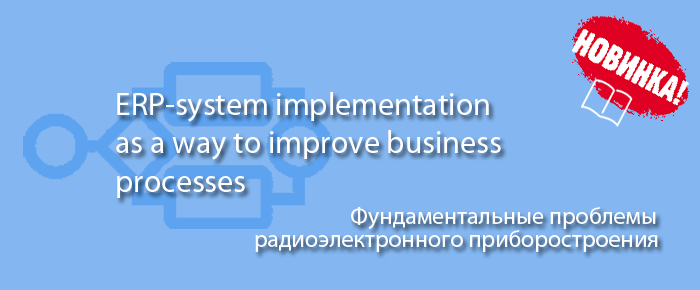ERP-system implementation as a way to improve business processes
- Подробности
- Опубликовано: 16.07.2018 16:52
- Автор: Степанов Дмитрий Юрьевич
- Просмотров: 30106

Аннотация: the paper is devoted to ERP-system implementation. ERP-system implementation was considered as a way to improve business processes of enterprise. Advantages and disadvantages of this mean of business process improvement were analysed.
Скачать: PDF (версия 1), PDF (версия 2).
Ключевые слова: ERP-system, business process, business process management, business process improvement, business process modeling notation, business process analysis, BSP, business process reengineering, CPI, TQM, CMM, capability maturity model, BPR, as is, to be, совершенствование бизнес процессов, реинжиниринг бизнес процессов предприятия, улучшение бизнес процессов, автоматизация бизнес процессов, автоматизация бизнес процессов предприятия, подходы к улучшению бизнес-процессов организации, совершенствование системы управления бизнес процессами предприятия, инструменты совершенствования бизнес-процессов, подходы к улучшению бизнес-процессов, пути совершенствования бизнес-процессов, реализация ERP-системы как способ улучшения бизнес-процессов.
Growing business dictates his own conditions to enterprise. Sometimes there is need to break the rules and move from one business model to another. Each business model involves business processes optimized and localized to specific company needs [1]. Transition from one model to other requires business processes amendments. There are a lot of ways to improve business processes like Business System Planning, Continuous Process Improvement, Total Quality Management [2] (fig.1).
Fig. 1. Ways to improve business processes
One of the way to do it is using Enterprise Resource Planning systems (ERP-system). ERP-system can be considered as a set of Information Systems (IS) integrated together within company [3]. Information System has realized business processes for particular business cases. There are limited number of processes within ERP-system. The feature of ERP-system is that all processes are predefined and well known before system implementation.
Objectives
The objective of the paper is considering ERP-system as business processes improve engine to obtain company effectiveness. To realize this aim ERP-system will be analyzed, advantages and disadvantages of the system will be discussed.
1. ERP-system architecture
Business objects are the basis of ERP-system (like Purchase Order, Goods Receipt, Incoming Invoice etc.). Combination of business objects shapes business process (fig.2). Business process improvement lies in process analysis, modification and optimization. As a result, processes are converted into a new once. Most improvement methods (fig.1) require special algorithms based on complex assessment, best practices and regulations. Using ERP-systems are quite different. Processes in ERP-system are built based on business objects. If for example someone needs to realize business process within ERP, the only way to do it just using predefined objects, which cannot be combined spontaneously. So, «TO BE» model is almost ready and are founded on sets of ERP business objects. Moreover, the model is optimized and approved [4].
Fig. 2. ERP-system architecture
2. Advantages and disadvantages of ERP-systems
Let us consider advantages and disadvantages of ERP-system implementation as process improvement method [5]. At first, we have to understand clearly, that ERP-system is not just an application. There is Enterprise Resource Planning strategy to optimize sales, purchasing, production and financials activities inside company. ERP-system is only one means to program this strategy.
ERP-system implementation has strong points displayed at tab.1. Such systems obtain already predefined solutions based on building blocks. This is very important because we know «TO BE» model even without deep analysis of «AS IS» business process situation. Hence, analysis stage does not take too much time. The difference between ERP and IS systems is in automation size: ERP covers almost all processes of enterprise in spite of IS involving only partial solutions. ERP-system orients to holdings, multinational companies and corporation at a time IS – departments.
Go to weak points of ERP-systems. We talked about predefined business solution, than need to mention company specifics. Each enterprise has unique processes, this is fact. None typical ERP-solution can manage such case. As a result, there is need in analysis and «AS IS», «TO BE» modelling. If ERP-system covers whole company, then solution is not flexible to any legislation changes. Each modification of existing application demands many efforts. In addition, each simple operation at real life turns into sharp challenge in ERP-system.
To mitigate disadvantages ERP-solutions typically supplied for each industry (industrial solutions). Moreover, there are quite different solutions per size business. To reduce complexity of ERP modifications, local and global support centers organized. Monitoring law changes and reflecting them into system are their responsibility. Using document templates as much as possible is the way to simplify operational routines at ERP.
Table 1. ERP-systems advantages and disadvantages
| № |
Advantages |
Disadvantages |
Weak point mitigation |
| 1 | Already optimized and approved building blocks | Company specific not taken into account | Industrial solution |
| 2 | Predefined solution based on building blocks | Complication of process to be reflected in ERP-system | Document templates |
| 3 | Most typical business scenarios considered | Modification of ERP-system processes takes too much efforts | Support centers |
| 4 | Low ERP-system process changes while implementing | Too much adopted to particular ERP-solution | N/A |
| 5 | Automation within entire company or holding | If any changes, all relevant processes must be reconsidered | N/A |
Transformation business processes from «AS IS» to «TO BE» model takes much time. The problem is you have to know how to transfer processes. In case of ERP-systems, you should not think too much about it as each process could be realized using determined system objects. Thereby, if you deal with a particular process not reflected at ERP-system you must adjust it to extant business processes or objects. Definitely, it’s not perfect way to renovate business model. However, taking into consideration that described processes already developed, optimized and approved in ERP-system you can change your mind completely. That is why almost all big size companies already followed this method to improve business processes.
Conclusions
The article contain brief review one of the way to improve business processes based on ERP-system implementation. The way has his own advantages and disadvantages, but focus is made on full company automation. Real life business processed are mapped and reflected to predefined ERP functionality. Thus, optimization and adaptation already realized in ERP building blocks (upon business objects variations). The prospect for the future is analyzing well-known improvement methods more detail.
References
- Hamilton S. Maximizing Your ERP System: A Practical Guide for Managers. – NY.: McGraw-Hill, 2002. – 350 p.
- Magal S.R., Word J. Essentials of Business Processes and Information Systems. – Germany: Wiley, 2009. – 200 p.
- Stepanov D.Yu. Analysis, design and development of enterprise resource planning systems: abstract / MIREA. - М., 2015.
- Wallace T. ERP: Making it happen. – Canada: John Wiley & Sons, 2001. – 375 p.
- Kocaoglu B., Acar A.Z. Developing an ERP Triggered Business Process Improvement Cycle from a Case Company: Proceeding of third International Conference on Leadership, Technology and Innovation Management, May 2015 // Procedia – Social and Behavioral Sciences. – 2015. – vol.181. – p.107-114.
Paper details
Stepanov D.Yu. ERP-system implementation as a way to improve business processes // Fundamental problems of radioengineering and device construction. – 2015. – vol.15, №1. – p.156-158. – URL: http://stepanovd.com/science/33-article-2015-4-bpmerp.






